Unit 6 My e-friend 教案(8个课时)
文档属性
| 名称 | Unit 6 My e-friend 教案(8个课时) | 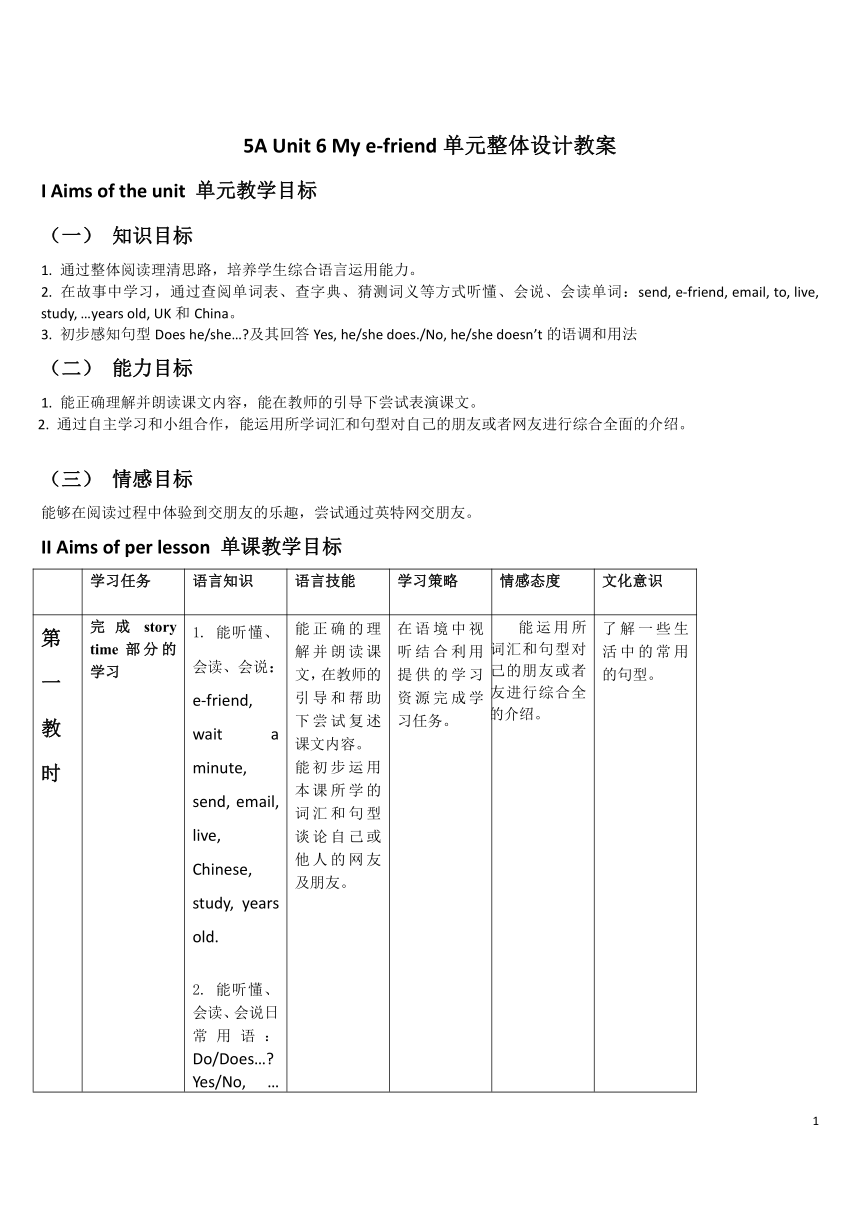 | |
| 格式 | zip | ||
| 文件大小 | 40.0KB | ||
| 资源类型 | 教案 | ||
| 版本资源 | 牛津译林版 | ||
| 科目 | 英语 | ||
| 更新时间 | 2019-10-18 14:10:25 | ||
图片预览

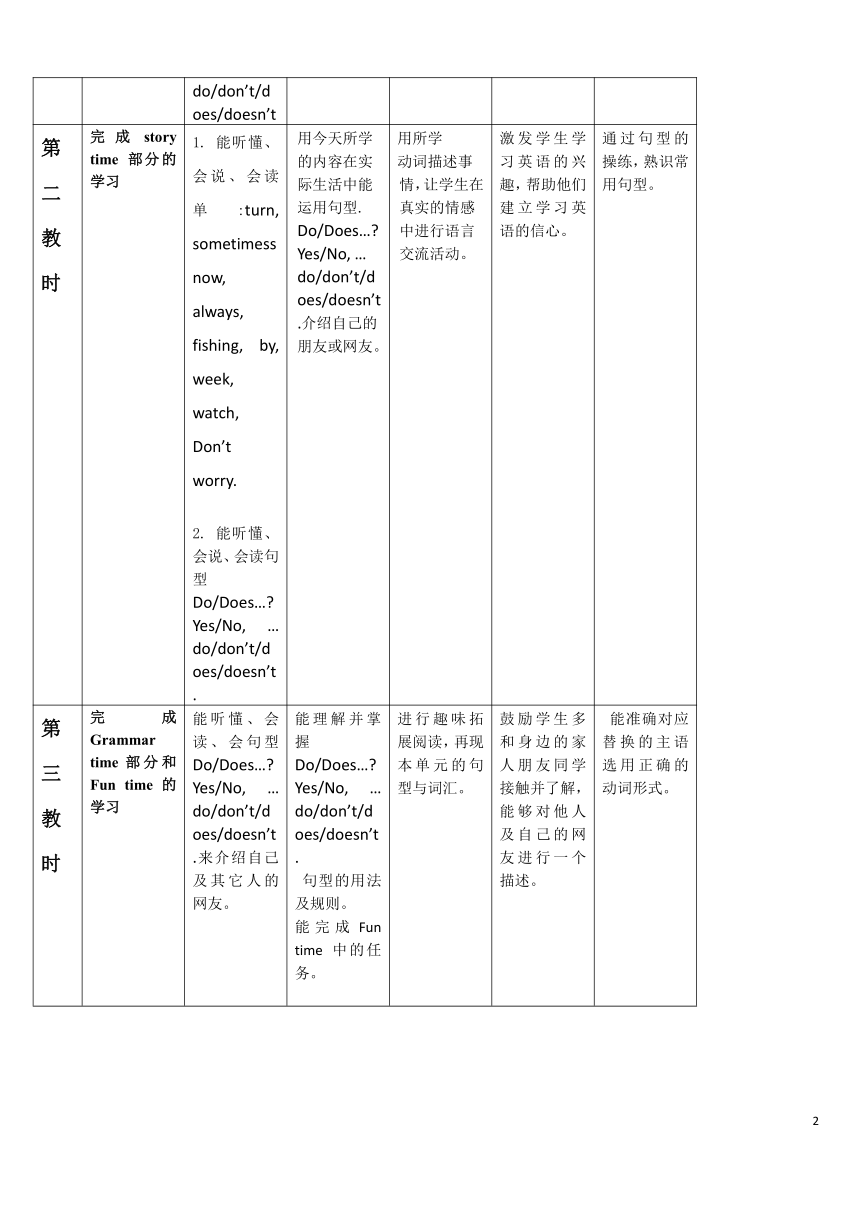
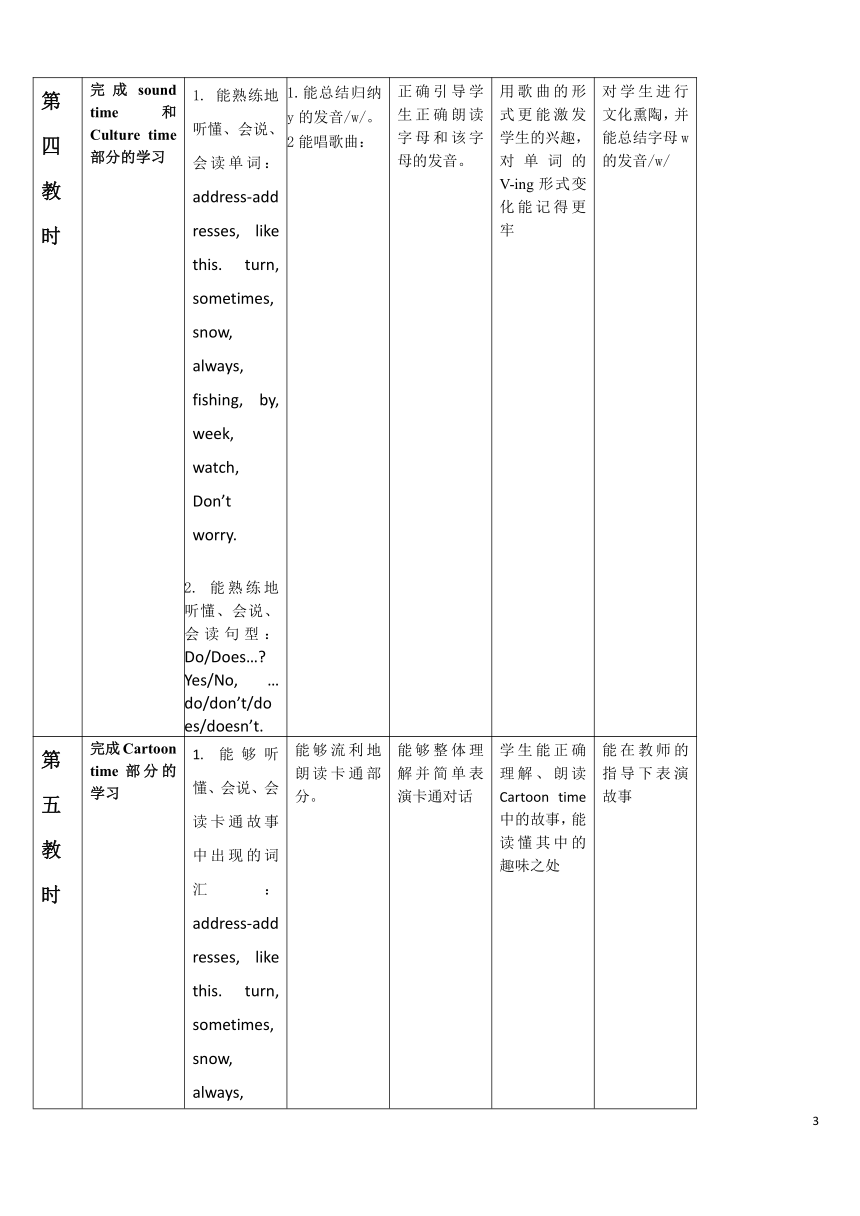
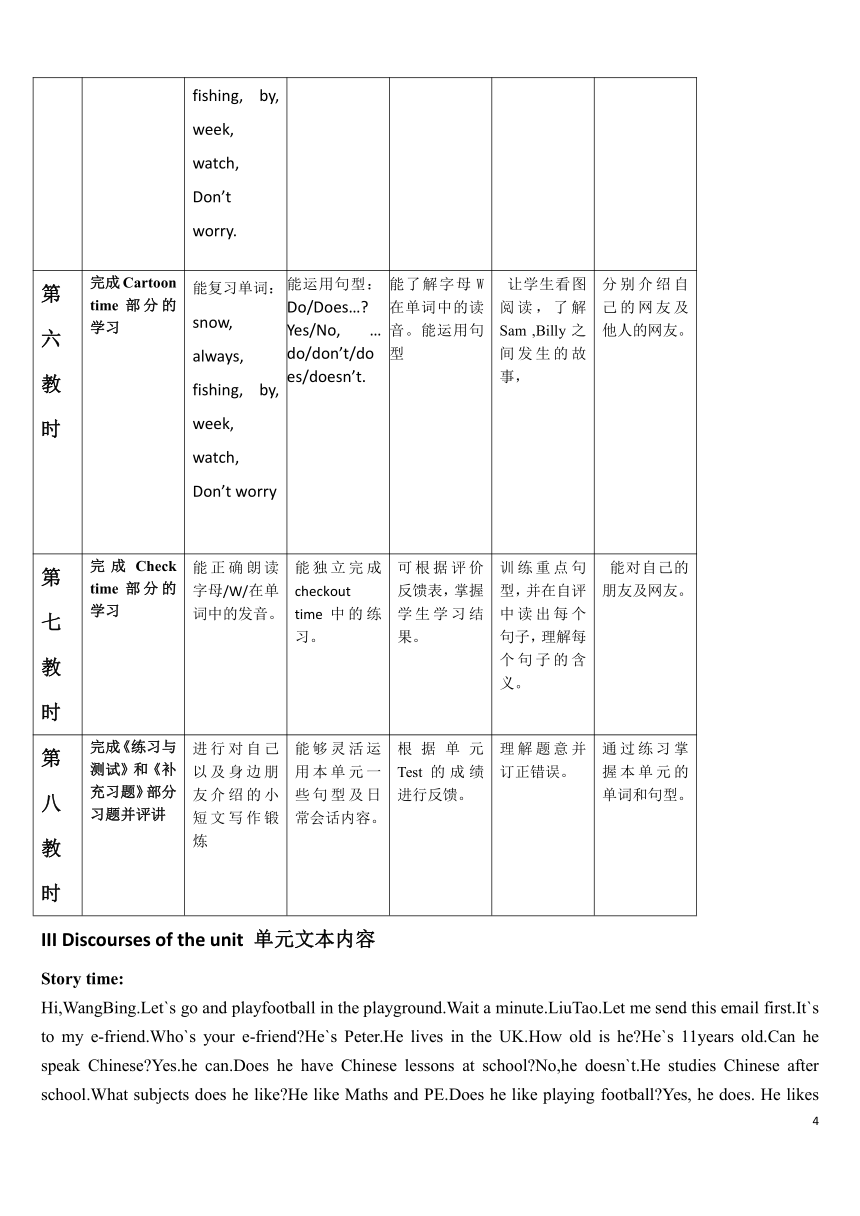
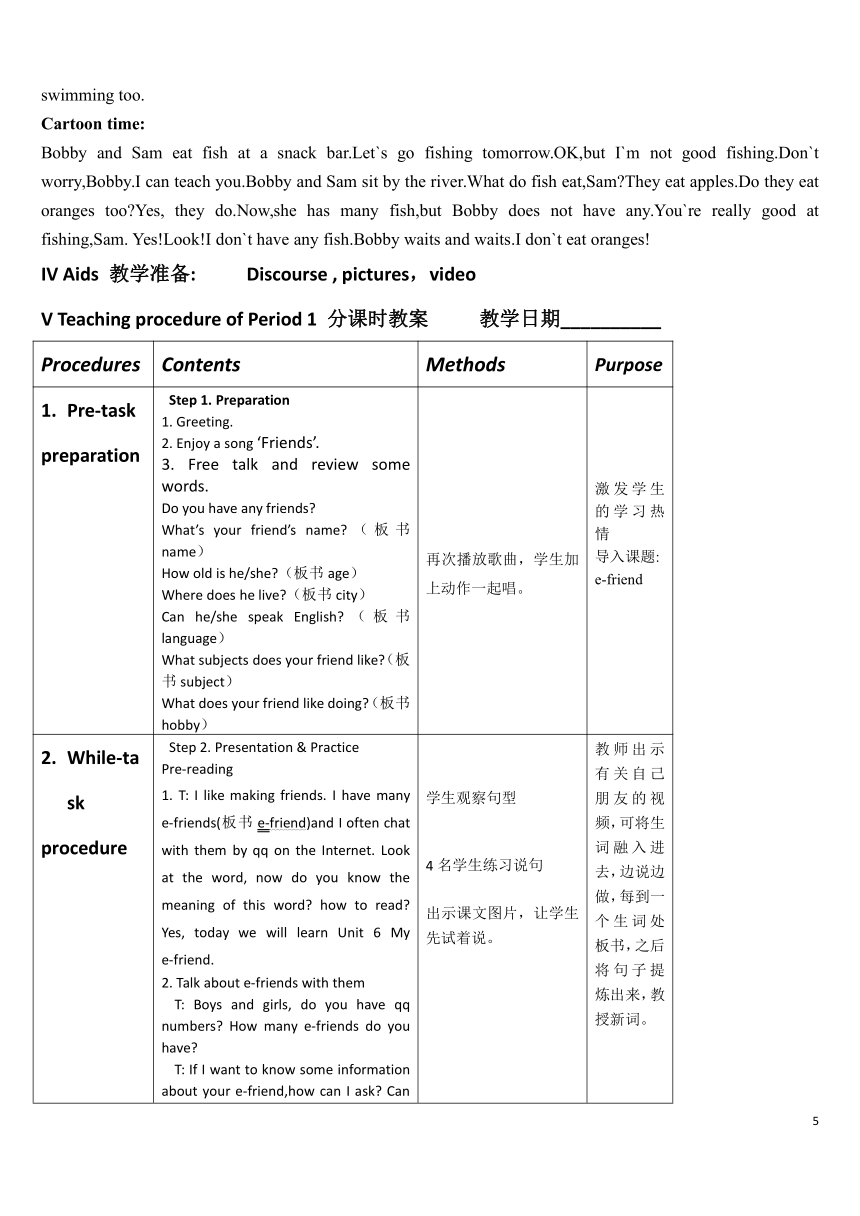
文档简介
5A Unit 6 My e-friend单元整体设计教案
I Aims of the unit 单元教学目标
(一) 知识目标
1. 通过整体阅读理清思路,培养学生综合语言运用能力。
2. 在故事中学习,通过查阅单词表、查字典、猜测词义等方式听懂、会说、会读单词:send, e-friend, email, to, live, study, …years old, UK和China。
3. 初步感知句型Does he/she…?及其回答Yes, he/she does./No, he/she doesn’t的语调和用法
(二) 能力目标
1. 能正确理解并朗读课文内容,能在教师的引导下尝试表演课文。
2. 通过自主学习和小组合作,能运用所学词汇和句型对自己的朋友或者网友进行综合全面的介绍。
(三) 情感目标
能够在阅读过程中体验到交朋友的乐趣,尝试通过英特网交朋友。
II Aims of per lesson 单课教学目标
学习任务
语言知识
语言技能
学习策略
情感态度
文化意识
第
一
教
时
完成story time部分的学习
1. 能听懂、会读、会说:e-friend, wait a minute, send, email, live, Chinese, study, years old.
2. 能听懂、会读、会说日常用语:Do/Does…? Yes/No, … do/don’t/does/doesn’t
能正确的理解并朗读课文,在教师的引导和帮助下尝试复述课文内容。
能初步运用本课所学的词汇和句型谈论自己或他人的网友及朋友。
在语境中视听结合利用提供的学习资源完成学习任务。
能运用所学词汇和句型对自己的朋友或者网友进行综合全面的介绍。
了解一些生活中的常用的句型。
第
二教
时
完成story time 部分的学习
1. 能听懂、会说、会读单:turn, sometimessnow, always, fishing, by, week, watch, Don’t worry.
2. 能听懂、会说、会读句型Do/Does…? Yes/No, … do/don’t/does/doesn’t.
用今天所学的内容在实际生活中能运用句型. Do/Does…? Yes/No, … do/don’t/does/doesn’t.介绍自己的朋友或网友。
用所学
动词描述事情,让学生在真实的情感中进行语言交流活动。
激发学生学习英语的兴趣,帮助他们建立学习英语的信心。
通过句型的操练,熟识常用句型。
第
三
教
时
完成Grammar time部分和Fun time的学习
能听懂、会读、会句型Do/Does…? Yes/No, … do/don’t/does/doesn’t.来介绍自己及其它人的网友。
能理解并掌握Do/Does…? Yes/No, … do/don’t/does/doesn’t.
句型的用法及规则。
能完成Fun time 中的任务。
进行趣味拓展阅读,再现本单元的句型与词汇。
鼓励学生多和身边的家人朋友同学接触并了解,能够对他人及自己的网友进行一个描述。
能准确对应替换的主语选用正确的动词形式。
第
四
教
时
完成sound time 和Culture time部分的学习
1. 能熟练地听懂、会说、会读单词:address-addresses, like this. turn, sometimes, snow, always, fishing, by, week, watch, Don’t worry.
2. 能熟练地听懂、会说、会读句型:Do/Does…? Yes/No, … do/don’t/does/doesn’t.
1.能总结归纳y的发音/w/。
2能唱歌曲:
正确引导学生正确朗读字母和该字母的发音。
用歌曲的形式更能激发学生的兴趣,对单词的V-ing形式变化能记得更牢
对学生进行文化熏陶,并能总结字母w的发音/w/
第
五
教
时
完成Cartoon time部分的学习
1. 能够听懂、会说、会读卡通故事中出现的词汇:address-addresses, like this. turn, sometimes,snow, always, fishing, by, week, watch, Don’t worry.
能够流利地朗读卡通部分。
能够整体理解并简单表演卡通对话
学生能正确理解、朗读Cartoon time中的故事,能读懂其中的趣味之处
能在教师的指导下表演故事
第
六
教时
完成Cartoon time部分的学习
能复习单词:snow, always, fishing, by, week, watch, Don’t worry
能运用句型:Do/Does…? Yes/No, … do/don’t/does/doesn’t.
能了解字母W在单词中的读音。能运用句型
让学生看图阅读,了解Sam ,Billy之间发生的故事,
分别介绍自己的网友及他人的网友。
第
七
教
时
完成Check time部分的学习
能正确朗读字母/W/在单词中的发音。
能独立完成checkout time中的练习。
可根据评价反馈表,掌握学生学习结果。
训练重点句型,并在自评中读出每个句子,理解每个句子的含义。
能对自己的朋友及网友。
第
八
教
时
完成《练习与测试》和《补充习题》部分习题并评讲
进行对自己以及身边朋友介绍的小短文写作锻炼
能够灵活运用本单元一些句型及日常会话内容。
根据单元Test的成绩进行反馈。
理解题意并订正错误。
通过练习掌握本单元的单词和句型。
III Discourses of the unit 单元文本内容
Story time:
Hi,WangBing.Let`s go and playfootball in the playground.Wait a minute.LiuTao.Let me send this email first.It`s to my e-friend.Who`s your e-friend?He`s Peter.He lives in the UK.How old is he?He`s 11years old.Can he speak Chinese?Yes.he can.Does he have Chinese lessons at school?No,he doesn`t.He studies Chinese after school.What subjects does he like?He like Maths and PE.Does he like playing football?Yes, he does. He likes swimming too.
Cartoon time:
Bobby and Sam eat fish at a snack bar.Let`s go fishing tomorrow.OK,but I`m not good fishing.Don`t worry,Bobby.I can teach you.Bobby and Sam sit by the river.What do fish eat,Sam?They eat apples.Do they eat oranges too?Yes, they do.Now,she has many fish,but Bobby does not have any.You`re really good at fishing,Sam. Yes!Look!I don`t have any fish.Bobby waits and waits.I don`t eat oranges!
IV Aids 教学准备: Discourse , pictures,video
V Teaching procedure of Period 1 分课时教案 教学日期__________
Procedures
Contents
Methods
Purpose
Pre-task
preparation
Step 1. Preparation
1. Greeting.
2. Enjoy a song ‘Friends’.
3. Free talk and review some words.
Do you have any friends?
What’s your friend’s name?(板书name)
How old is he/she?(板书age)
Where does he live?(板书city)
Can he/she speak English?(板书language)
What subjects does your friend like?(板书subject)
What does your friend like doing?(板书hobby)
再次播放歌曲,学生加上动作一起唱。
激发学生的学习热情
导入课题:
e-friend
While-task
procedure
Step 2. Presentation & Practice
Pre-reading
1. T: I like making friends. I have many e-friends(板书e-friend)and I often chat with them by qq on the Internet. Look at the word, now do you know the meaning of this word? how to read? Yes, today we will learn Unit 6 My e-friend.
2. Talk about e-friends with them
T: Boys and girls, do you have qq numbers? How many e-friends do you have?
T: If I want to know some information about your e-friend,how can I ask? Can you give me some suggestion?
S: ...
T: (师边指黑板边总结)Yes ,you may say “What’s your e-friend’s name?How old is he/she?Where does he live?”and so on.
3.Ask and answer
T: Boys and girls, please take out your friend ‘s photo and talk with your deskmates .If you don’t know how to ask ,you can open your books and turn to page 66 Ask and answer.
T: Look, who is he ?(出示Wang Bing图片)
S: He’s Wang Bing.
T: He has an e-friend too.Who is his e-friend? Please read by yourselves and answer me some questions.
While-reading
1. Read the text and underline
Q: How many questions does Liu Tao ask ?What are they?Please open your books and underline these sentences.
2.Let’s check .
3.Watch the cartoon.
T: This time,let’s watch the cartoon and tell me the information about Peter.
4. T: Wait a minute,there’s something wrong on the Internet. Let me have a look.
Teach the word: Wait a minute
5. Check the answer
学生观察句型
4名学生练习说句
出示课文图片,让学生先试着说。
教师边板书边总结
小组活动,介绍自己的朋友。(四人一组,教师可提供必要的词汇帮助学生。)
跟读2-3次,注意发音和语调,培养学生的语感
五分钟左右熟读并尝试理解
教师出示有关自己朋友的视频,可将生词融入进去,边说边做,每到一个生词处板书,之后将句子提炼出来,教授新词。
主要复习巩固所学内容。
总结本节课所学知识帮助学生理清新课知识体系。
Post
-task
activities
Step3 Production.
1. Read the story.
1) Read after the tape.
2) Read in roles.
2. Try to retell the story
T: Now children. Turn to page 60. Discuss in your group, and try to retell the story.
Step4 Progress.
After-reading
1.Think and write
T: Can you write?OK, Please try.
2. Listen and tick
T: Turn to page 66, let’s do the exercise.
新授语法通过课堂操练再次巩固。
解决难题,初步了解一般疑问句的用法。
Assignment
1.Read the story.
2.Try to tell this story to your friend.
Read more English stories after school.
On the
blackboard
Unit 6 My e-friend
Does he live in the UK?
Yes, he does.
Does he have black hair?
No, he doesn’t.
Does he like Maths?
Yes, he does. He likes PE too.
Does he like playing basketball?
No, he doesn't. He likes playing football.
Notes
Teaching procedure of Period 2 分课时教案 教学日期__________
Procedures
Contents
Methods
Purposes
1.Pre-task
preparation
Step 1. Preparation
Say a chant.
A. Warming up.
a. Free talk.
T: Good afternoon, boys and girls. I’m your new teacher today. Nice to see you. How are you today?
S: I’m fine, thank you. And you?
T: I’m fine, too.
b. Brain storming.
T: I’m new here. I want to know who the best is in our class. So first of all, let’s do brain storming.
Country: theUK...????
Subject: PE...???
Action: swim...
Hobby: I like playing football.?
课开始直接入题,复习上节课所学过的课文。
通过chant导入所学内容。
头脑风暴,操练所学句型。
复习上一课时的内容。给学生更多的练习口语的机会。
主要通过句型复习巩固所学内容。
2.While-task
procedure
B. Revision.
a.?Story time.
T: You are all very good. I know you have many hobbies. But do you know what my hobby is? I like reading stories. Here I have a story. Let’s read it together.
b. Dub the story time.
c. Ask and answer.
T: Who’s Wang Bing’s e-friend?
S: He’s Peter.
T: Yes, Peter is here today. He wants to make friends with you. Listen!
T: Let’s be Peter’s friend, ok? S: OK.
T: Let’s know Peter first.
e. Let’s?ask.?
C. Grammar time.
a.?Read and think.
T: OK. We know something about Peter now. Let’s look at these sentences. Can you find some rules?
S: ...
b. Summary.
T:?在一般现在时中,主语是第三人称单数,那么一般疑问句应用does来提问,行为动词保持原形。肯定回答,yes...does.否定回答no...doesn’t. 在肯定句中,行为动词要变形。
c. Read the sentences one by one.
d. Try to know your friends.
T: How do we know our e-friend? We can?ask?questions. Just like age, is he eleven years old? Or is she twelve years old? If I want to know the appearance, I can ask: Does he have big eyes?
S: Does he have...?
? ...
D. Fun time.
a. Fun time.
?T: We know Peter likes making friends. He makes some new friends in our English book. Who are they? Let’s?guess.
b. Give a model.
?(1)Four in a group and read the first card together.
?(2)The first student takes a card and look. The others?ask?questions: Does he like...? Does he have...? Does he like (doing)...? If they are right, the first student can show them the card and say: Yes, he/she does. If all of them are wrong, the first student can show them the card and say: No, he/she doesn’t. He/She likes...
?(3)When they have 5 cards. They can read the cards one by one and?guess?who is he/she.
?(4) Show the report.
c. Play the game in groups.?
d. Our report.
E. Workbook. (P28 C Read and say)
a.?New e-friend.
? T: Peter has so many friends in our English book. He also has some e-friends on the Internet. Look, this is the face book. We can see some child here. Who are they?
She’s Amy. She’s ... (Read together.)
b. Listen to Peter.
? T: Who’s Peter’s e-friend? Let’s listen.
c. Listen and answer.
? T: Who’s Peter’s new e-friend?
? S: She’s Amy.
? T: Are you right? Let’s read.
? Ss: My e-friend is a girl.
...
? T: Yes, you’re right. Amy is Peter’s e-friend. She’s a good friend, I think. Do you want to have an e-friend?
? S: Yes.
? T: Then please choose one.
d. Choose your e-friend. (将所选头像贴于练习纸上)
e. Talk about your e-friend.
f. Write your e-friend’s information.
g. Show time.
??
复习
在同学说完后,就指着最后回答问题的人说T:Does She/He like doing …教授He/She likes doing…
用小chant引起学生的兴趣
讲解一般现在时
让学生自己介绍一下自己的e-friend.
Tip: like后面的动词一定要加ing哦!
Tip: 陈述句中,主语是第三人称单数时,动词后要加s或es哦!
培养学生对单词的快速反映能力
主要是复习巩固所学内容,
主要让学生试着进行描述一下。
3.Post-task
activities
F. Consolidation.
T: Boys and girls, today we learned how to get the information.当我想知道他住在什么地方的时候,可以问:Does he
live in theUK? 当我想知道他的外貌的时候,可以问:Does he have black hair? ...
? T:? We know friends are very important. A life without a friend is a life without a sun. So take care your friends and try to get more friends.
?like...? Does he have...? Does he like (doing)...? If they are right, the first student can show them the card and say: Yes, he/she does. If all of them are wrong, the first student can show them the card and say: No, he/she doesn’t. He/She likes...
?
做好笔记回顾本课所学。
在游戏中交际。
在交际中练习口语。
Assignment
G. Homework.
1. Introduce your new e-friend to your classmate or parents.
2. Learn how to write an e-mail.
?
On the
blackboard
Unit 6 My e-friend
Does he live in the UK?
Yes, he does.
Does he have black hair?
No, he doesn’t.
Does he like Maths?
Yes, he does. He likes PE too.
Does he like playing basketball?
No, he doesn't. He likes playing football.
Notes
Teaching procedure of Period 3 分课时教案 教学日期__________
Procedures
Contents
Methods
Purposes
1.Pre-task
preparation
Step 1. Preparation
b. Brain storming.
? T: I’m new here. I want to know who the best is in our class. So first of all, let’s do brain storming.
? Country: the UK...????
? Subject: PE...???
? Action: swim...
? Hobby: I like playing football.?
T: Yes, you’re right. Amy is Peter’s e-friend. She’s a good friend, I think. Do you want to have an e-friend?
? S: Yes.
? T: Then please choose one.
d. Choose your e-friend. (将所选头像贴于练习纸上)
e. Talk about your e-friend.
f. Write your e-friend’s information.
g. Show time.
问3-4名学生,将表示朋友的词汇板书
让学生尝试着说一说。
通过free talk复习上节课的句型,巩固所学知识。
2.While-task
procedure
T: We know Peter likes making friends. He makes some new friends in our English book. Who are they? Let’s?guess.
b. Give a model.
?(1)Four in a group and read the first card together.
?(2)The first student takes a card and look. The others?ask?questions: Does he
T:? We know friends are very important. A life without a friend is a life without a sun. So take care your friends and try to get more friends.
?like...? Does he have...? Does he like (doing)...? If they are right, the first student can show them the card and say: Yes, he/she does. If all of them are wrong, the first student can show them the card and say: No, he/she doesn’t. He/She likes...
可以将学生分成两组,一组负责第一个表格中的句子,一组负责答句。
可以用多媒体或者在黑板上呈现表格中的句子,然后将其中的关键词覆盖,要求学生填空。
教师先将有关兴趣爱好类动词列在黑板的一侧,要求学生认读,
然后再和学生一起写出这些动词的动名词形式
。
动词转化为动名词的规则:一般在动词后直接加-ing,有些动词则先要去掉字母e或双写尾字母再加-ing。
3.Post-task
activities
Step3 Production.
1. Read the story.
1) Read after the tape.
2) Read in roles.
2. Try to retell the story
T: Now children. Turn to page 60. Discuss in your group, and try to retell the story.
Step4 Progress.
After-reading
1.Think and write
T: Can you write?OK, Please try.
2. Listen and tick
T: Turn to page 66, let’s do the exercise.
操练这一语法规则,出示经常用到的动词。
讲解人物的介绍。
多次操练加强记忆
运用本节课所学知识帮助学生理清新课知识体系。
Assignment
On the
blackboard
Unit 6 My e-friend
Does he live in the UK?
Yes, he does.
Does he have black hair?
No, he doesn’t.
Does he like Maths?
Yes, he does. He likes PE too.
Does he like playing basketball?
No, he doesn't. He likes playing football.
Notes
Teaching procedure of Period 4 分课时教案 教学日期__________
Procedures
Contents
Methods
Purposes
1.Pre-task
preparation
Step 1. Preparation
Greetings and free talk.
Do some exercises of the letter “w
Check the answers.
自由对话,复习了前面课文中学到的重点句型
复习上一课时的内容, 也是为下面的检测巩固做基础。
2.While-task
procedure
Look at the pictures.
Talk about the pictures and the sentences.
Talk about the pictures.
Listen to the tape.
Teach the new words: address-addresses, like this
Read the short text.
Ask and answer.
Act the short text.
He lives in the UK. He’s 11 years old. He studies Chinese after school. He likes Maths and PE. He likes playing football and swimming.
Teach the different addresses in Chinese and in English.
Look at the pictures.
Talk about the pictures and sentences.
游戏规则:快速闪现单词,词组
让学生读单词,体会字母w的发音/w/
让学生归纳以前所学单词中字母w的发音/w/
注意语音语调,以及节奏,可组织多种形式的竞赛活动。
3.Post-task
activities
T: What country is it?
Talk about the pictures and sentences.
Read and write some sentences.
Read the new vocabulary.
Make some dialogues: This is my e-friend. He/She ….
G. Homework.
1. Recite the vocabulary and patterns.
2. Finish the workbooks.
播放录音,要求学生跟读歌曲。
分组演唱,可以替换歌词。
老师出示若干表示文体活动的单词卡片,让学生从中挑选一项自己喜欢的活动,结合本单元句型,进行问答活动,复习本单元的词汇和句型。
On the
blackboard
Unit6 My e-friend
We write Chinese addresses like this.
We write English addresses like this
XX is my e-friend. He/She lives …. He’s/She’s … years old. He/She likes …. He/She can ….
Teaching procedure of Period 5 分课时教案 教学日期__________
Procedures
Contents
Methods
Purposes
1.Pre-task
preparation
Step 1. Preparation
Greetings and free talk.
Do some exercises of the letter “w”.
Check the answers.
T: What country is it?
Talk about the pictures and sentences.
Read and write some sentences.
Read the new vocabulary.
师生进行日常对话。
积极参加对话,并在教师的引导下操练句型。
再次复习上节课的句型
2.While-task
procedure
. Step 2. Presentation & Practice
Look at the pictures.
Action: swim...
? Hobby: I like playing football.?
T: Yes, you’re right. Amy is Peter’s e-friend. She’s a good friend, I think. Do you want to have an e-friend?
? S: Yes.
? T: Then please choose one.
d. Choose your e-friend. (将所选头像贴于练习纸上)
e. Talk about your e-friend.
f. Write your e-friend’s information.
g. Show time.
Teach the new words: turn, sometimes, snow, always, week, watch
Read the short text.
Act the short text.
Find the other words.
Do some exercises.
Check the answers:
T: Look at the pictures, who are they?
S: Sam and Bobby.
T: What are they doing? Watch the cartoon, please.
Watch the cartoon.
师生讨论卡通人物Sam和Billy 可能有的兴趣爱好,为阅读故事做准备。
出示第一幅挂图
教师可出示故事的第一幅图片作为提示
教师找2-3名学生说说看的内容,鼓励学生用几句英语叙述。
3.Post-task
activities
Step3 Production.
Ask and answer the questions, then fill the forms:
Bobby and Sam-eat fish at a snack bar, go fishing, sit by the river, waits and waits, Don’t worry
Listen to the tape and notice the pronunciations and intonations.
Teach the new words: Don’t worry, by, fishing
Read after the tape.
Choose one kind of reading and read in groups.
教师准备几个问题,让学生有目的的朗读
设计练习再次检测学生的理解情况
模仿卡通部分编一段对话,要突出趣味
Assignment
On the
blackboard
Unit6 My e-friend
turn sometimes snow always week watch
w-/w/
Don’t worry fishing
Notes
Teaching procedure of Period 6分课时教案 教学日期__________
Procedures
Contents
Methods
Purposes
1.Pre-task
preparation
Step 1. Preparation
Say a chant.
?Do, do, do you have a friend?
?Yes, yes, I have a friend.
?Does, does, does he like Maths?
?Yes, yes, yes, he does.
?Does, does, does he skate well?
?No, no, he swims well.
A. Warming up.
a. Free talk.
? T: Good afternoon, boys and girls. I’m your new teacher today. Nice to see you. How are you today?
? S: I’m fine, thank you. And you?
? T: I’m fine, too.
积极参加对话,并在教师的引导下操练句型。
复习上一课时的内容。
2.While-task
procedure
Look at the pictures.
Talk about the pictures and the sentences.
Talk about the pictures.
Listen to the tape.
Teach the new words: address-addresses, like this
Read the short text.
Ask and answer.
Act the short text.
He lives in the UK. He’s 11 years old. He studies Chinese after school. He likes Maths and PE. He likes playing football and swimming.
Teach the different addresses in Chinese and in English.
Look at the pictures.
Talk about the pictures and sentences.
对图片进行描述。
出示Billy
学生小组内讨论,教师板书。
引导学生进行自主学习。
进行拓展。
注意语音语调
3.Post-task
activities
Step 4 Consolidation
1.Think and write
T: Can you write?OK, Please try.
2. Listen and tick
T: Turn to page 66, let’s do the exercise.
注意句子的语音语调和节奏。
Assignment
1. 听录音10分钟,熟读课文并能背诵课文。
2. 完成英语《课课练》上面的习题。
3. 复习Unit4内容。
On the
blackboard
Unit 6 My e-friend
Does he live in the UK?
Yes, he does.
Does he have black hair?
No, he doesn’t.
Does he like Maths?
Yes, he does. He likes PE too.
Does he like playing basketball?
No, he doesn't. He likes playing football.
Teaching procedure of Period 7分课时教案 教学日期__________
Procedures
Contents
Methods
Purposes
1.Pre-task
preparation
Step1. Free talk
Step 1. Preparation
b. Brain storming.
? T: I’m new here. I want to know who the best is in our class. So first of all, let’s do brain storming.
? Country: the UK...????
? Subject: PE...???
T:? We know friends are very important. A life without a friend is a life without a sun. So take care your friends and try to get more friends.
?like...? Does he have...? Does he like (doing)...? If they are right, the first student can show them the card and say: Yes, he/she does. If all of them are wrong, the first student can show them
复习已学内容,巩固所学知识。
找几位发音正确的学生朗读,其他学生跟读。
复习本单元的知识。
小组讨论,开启学生思维风暴
2.While-task
procedure
T: Then please choose one.
d. Choose your e-friend. (将所选头像贴于练习纸上)
e. Talk about your e-friend.
f. Write your e-friend’s information.
g. Show time.
Teach the new words: turn, sometimes, snow, always, week, watch
Read the short text.
Act the short text.
Find the other words.
Do some exercises.
Check the answers:
T: Look at the pictures, who are they?
S: Sam and Bobby.
T: What are they doing? Watch the cartoon, please.
Watch the cartoon.
来询问并看图回答
Encourage Ss to win more stars
小组交流展示
用评星的方式鼓励孩子学习。
Assignment
完成补充练习和练习与测试练习。
熟背本单元课文。
On the
blackboard
Unit 6 My e-friend
Does he live in the UK?
Yes, he does.
Does he have black hair?
No, he doesn’t.
Does he like Maths?
Yes, he does. He likes PE too.
Does he like playing basketball?
No, he doesn't. He likes playing football.
Notes
Teaching procedure of Period 8分课时教案 教学日期__________
Procedures
Contents
Methods
Purposes
1.Pre-task
preparation
Step 1. Preparation
Greetings and free talk.
Do some exercises of the letter “w”.
Check the answers.
T: What country is it?
Talk about the pictures and sentences.
Read and write some sentences.
Read the new vocabulary.
T: Then please choose one.
d. Choose your e-friend. (将所选头像贴于练习纸上)
e. Talk about your e-friend.
f. Write your e-friend’s information.
g. Show time.
复习已学内容,巩固所学知识。
教师先让学生仔细观察六幅图片,然后播放录音,让学生根据录音内容填写序号。
教师先让学生迅速浏览答句,理解意思,想想答句可能对应的问句形式,然后播放录音,让学生选择答句。
复习本单元的知识。
教师可以先让学生先根据图片上的人物活动和所给语言提示理解本题大意,然后再和同伴进行交流,注意like doing的正确表达。
教师可以先让学生读一读对话,然后仔细观察图片,并与短文内容对比,最后进行判断。
3.Post-task
activities
T: We know Peter likes making friends. He makes some new friends in our English book. Who are they? Let’s?guess.
b. Give a model.
?(1)Four in a group and read the first card together.
?(2)The first student takes a card and look. The others?ask?questions: Does he
T:? We know friends are very important. A life without a friend is a life without a sun. So take care your friends and try to get more friends.
?like...? Does he have...? Does he like (doing)...? If they are right, the first student can show them the card and say: Yes, he/she does. If all of them are wrong, the first student can show them
完成练习。
学生自己分析题目2-3分钟。分析错题原因:记忆方面,理解方面和书写方面。
通过一些练习,及时发现学生在本单元学习中存在的问题,并解决。
Assignment
On the
blackboard
Unit 6 My e-friend
Does he live in the UK?
Yes, he does.
Does he have black hair?
No, he doesn’t.
Does he like Maths?
Yes, he does. He likes PE too.
Does he like playing basketball?
No, he doesn't. He likes playing football.
Notes
